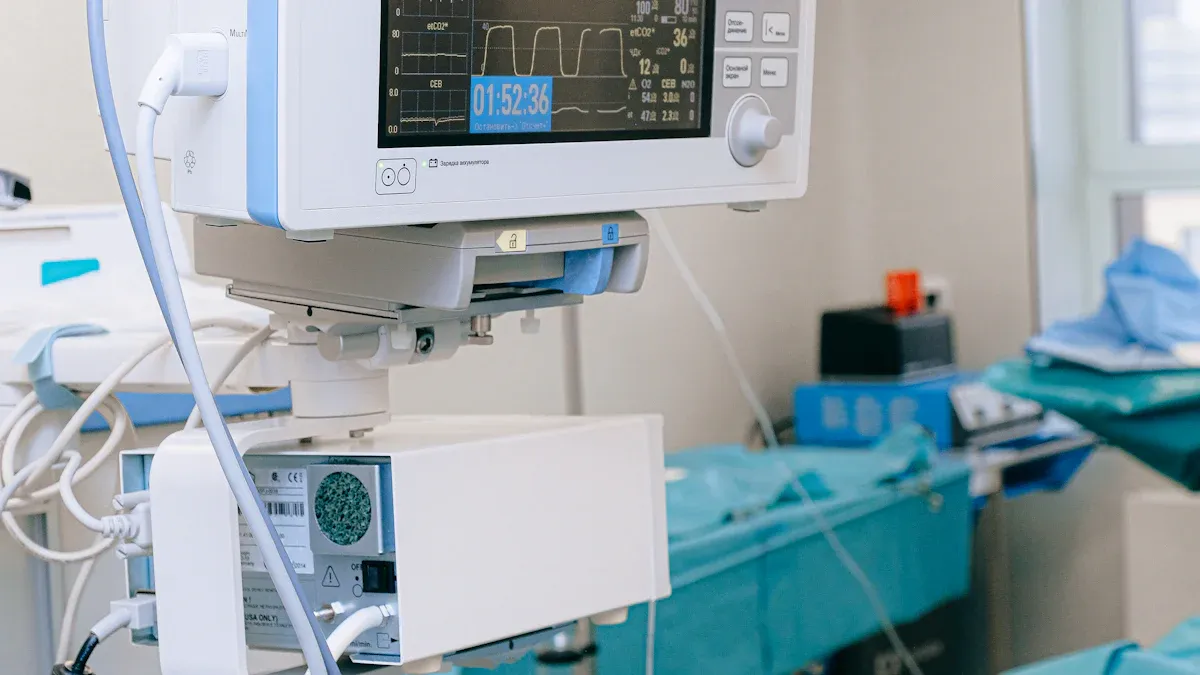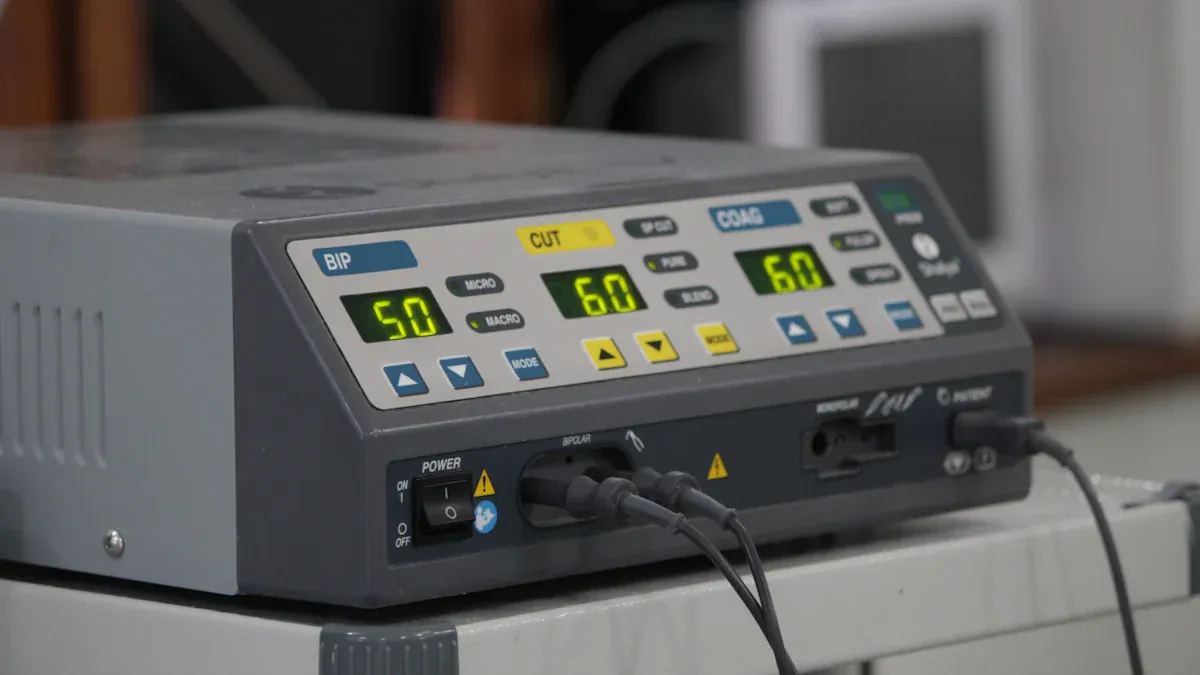
Hospitals depend on reliable power solutions to maintain critical operations. A medical-grade Power Distribution Unit ensures safe and consistent energy delivery to life-saving devices. Unlike a Basic PDU, these specialized units meet strict healthcare requirements. Intelligent PDU systems further optimize power management, reducing risks and enhancing patient safety.
Key Takeaways
- Medical-grade PDUs provide steady power to important medical tools. This keeps patients safe and helps hospitals work smoothly.
- These units follow strict healthcare rules to prevent electrical dangers. They also meet laws like HIPAA to stay compliant.
- Using medical-grade PDUs reduces power issues, improves patient care, and boosts hospital performance.
Understanding Medical-Grade Power Distribution Units
What Are Medical-Grade Power Distribution Units?
Medical-grade power distribution units (PDUs) are specialized devices designed to distribute electrical power safely and efficiently in healthcare environments. Unlike standard PDUs, these units meet stringent medical standards to ensure compatibility with sensitive medical equipment. They play a critical role in delivering uninterrupted power to life-saving devices, such as ventilators, imaging systems, and patient monitoring equipment. By adhering to strict safety and performance requirements, medical-grade PDUs help hospitals maintain operational reliability and patient safety.
Key Features That Set Them Apart
Medical-grade PDUs offer unique features tailored to the demanding needs of healthcare facilities. These features ensure that hospitals can operate efficiently while minimizing risks to patients and staff. The table below highlights some of the key advantages these units provide:
| Advantage | Description |
|---|---|
| Enhanced security | Protects against unauthorized access and breaches through encryption, access controls, and audit trails. |
| Increased compliance | Helps meet regulatory requirements like HIPAA, reducing the risk of fines and legal penalties. |
| Cost savings | Reduces costs associated with paper documents and non-compliance, saving the healthcare industry billions. |
| Sustainability | Minimizes paper usage, contributing to environmental conservation. |
| Protection against data loss | Ensures reliable backup and preservation of information, making it easy to retrieve necessary records. |
| Scalability | Allows organizations to efficiently manage increasing data volumes with cloud storage solutions. |
| Fewer errors | Improves accuracy in patient documentation, reducing the likelihood of medical errors. |
| Higher staff and patient satisfaction | Increases efficiency and transparency in care, leading to improved satisfaction for both staff and patients. |
These features make medical-grade PDUs indispensable in hospital settings. Their ability to enhance security, ensure compliance, and reduce errors directly contributes to better patient outcomes and operational efficiency.
Why Hospitals Need Specialized Power Solutions
Hospitals require specialized power solutions to address the unique challenges of healthcare environments. Standard power systems often fall short in meeting the critical demands of hospitals, where even a brief power outage can have life-threatening consequences. The following points highlight why medical-grade PDUs are essential:
- Hospitals depend on constant power to protect patients and sensitive data. Interruptions can compromise patient safety and disrupt critical operations.
- Power outages pose severe risks to life-saving equipment, such as ventilators and defibrillators, which require uninterrupted power to function effectively.
- Outdated electrical systems increase the likelihood of maintenance issues and outages, making modern power distribution units a necessity for hospitals.
By investing in medical-grade PDUs, hospitals can ensure reliable power delivery, reduce downtime, and maintain the highest standards of patient care.
The Role of Power Distribution Units in Patient Safety and Efficiency

Preventing Electrical Hazards in Hospitals
Electrical hazards in hospitals pose significant risks to both patients and staff. A well-designed power distribution unit minimizes these risks by ensuring stable and safe power delivery. Hospitals often operate complex electrical systems that power critical devices, lighting, and HVAC systems. Any electrical fault, such as a short circuit or power surge, can lead to equipment failure or even fires. Medical-grade power distribution units are equipped with advanced safety features like circuit breakers, surge protection, and fault detection mechanisms. These features prevent electrical hazards and maintain a safe environment for everyone in the facility.
Additionally, these units undergo rigorous testing to meet healthcare safety standards. Their compliance with regulations ensures that they can handle the unique demands of medical environments. By investing in these specialized units, hospitals can significantly reduce the likelihood of electrical accidents and enhance overall safety.
Supporting Critical Medical Equipment
Critical medical equipment relies on uninterrupted power to function effectively. Devices such as ventilators, dialysis machines, and imaging systems play a vital role in patient care. A power failure in these systems can have life-threatening consequences. Medical-grade power distribution units ensure a continuous power supply, even during fluctuations or outages. This reliability is essential for maintaining the functionality of life-saving equipment.
The growing demand for uninterrupted power in healthcare highlights the importance of these units. The global market for uninterruptible power supply (UPS) systems for medical equipment was valued at approximately USD 2.4 billion in 2023. It is projected to reach around USD 4.6 billion by 2032. This growth reflects the increasing need for reliable power solutions in hospitals. An aging population and the rise in chronic diseases further emphasize the necessity of these systems. By integrating medical-grade power distribution units, hospitals can safeguard critical equipment and ensure optimal patient care.
Enhancing Operational Continuity and Reducing Downtime
Operational continuity is crucial in healthcare settings. Any disruption can delay treatments, compromise patient safety, and increase operational costs. Medical-grade power distribution units play a pivotal role in reducing downtime by providing consistent power delivery. They also support condition-based maintenance (CBM), which uses real-time data to predict equipment failures. This proactive approach minimizes disruptions and ensures that critical systems remain operational.
Hospitals that adopt advanced power solutions report significant improvements in efficiency. For instance, the use of smart infusion devices has reduced drug replacement time by approximately 80.8% to 81.7%. This time savings allows healthcare professionals to focus more on patient care. Additionally, hospitals experience a 30% decrease in emergency maintenance calls and improved patient outcomes. These benefits demonstrate how medical-grade power distribution units enhance operational continuity and contribute to better healthcare delivery.
Compliance and Standards for Medical-Grade Power Distribution Units
Meeting Healthcare Safety Standards
Medical-grade power distribution units must comply with rigorous healthcare safety standards to ensure patient and operator safety. These standards address the unique challenges of medical environments, where electrical equipment must operate reliably under high-stakes conditions. Key safety standards include:
- IEC 60601: This standard ensures that medical devices pose no risk to patients or operators. It also addresses software and system aspects of medical equipment.
- IEC 60601-1: This subset focuses on the basic safety and essential performance of medical electrical equipment. It mandates increased protection levels for insulation, creepage, clearance, and leakage current.
- FDA and EU CE Marking: Compliance with these international regulatory bodies ensures that medical-grade PDUs meet stringent safety and performance criteria.
These standards guarantee that power distribution units can handle the demands of healthcare environments while minimizing risks.
Certification Requirements for Hospital Equipment
Certifications play a vital role in verifying the safety and reliability of medical-grade power distribution units. Hospitals rely on certified equipment to maintain compliance with healthcare regulations. Common certifications include:
- UL Certification: This certification ensures that medical-grade outlets and plugs meet additional safety requirements for patient care areas. UL 60601-1 certification is particularly important for sensitive medical equipment.
- CAN/CAS C22 Standards: These standards apply to hospital-grade power cables, ensuring their durability and reliability in critical applications.
- Hospital-Grade Plugs and Outlets: Equipment featuring these components provides enhanced safety and performance in patient care environments.
For example, the CyberPower M550L medical-grade UPS meets UL 60601-1 requirements, offering reliable power delivery for life-support equipment.
Ensuring Compatibility with Medical Devices
Medical-grade power distribution units must be compatible with a wide range of medical devices to ensure seamless operation. Electromagnetic interference (EMI) and electromagnetic compatibility (EMC) are critical factors in this regard. Compatibility assessments often include:
| Evidence Description | Source |
|---|---|
| Discusses the impact of EMI on medical devices and the necessity of EMC testing to ensure compatibility with power distribution units. | COSEL |
| Highlights the comprehensive approach required for EMC, including shielding, filtering, and adherence to regulatory standards. | COSEL |
| Explains how conducted noise from various systems can affect medical devices and suggests mitigation strategies. | COSEL |
| States that the FDA mandates EMC testing for medical devices under IEC 60601-1-2 standards, ensuring they meet specific immunity and emissions criteria. | Astrodynetdi |
| Describes the regulatory requirements for medical devices to withstand electromagnetic interference, ensuring reliable operation in real-world conditions. | COSEL |
These assessments ensure that medical devices can operate efficiently without interference, safeguarding patient care and operational continuity.
Reliability in Critical and Emergency Healthcare Scenarios

Managing Power Surges and Outages
Hospitals face significant risks from power surges and outages, which can disrupt critical operations and endanger patient lives. Medical-grade systems mitigate these risks through advanced technologies designed to maintain power stability. For instance:
- Utilities may preemptively shut down parts of the grid to prevent damage during natural disasters, demonstrating proactive risk management.
- Restoration plans often involve collaboration with organizations like FEMA and the Department of Defense, ensuring a coordinated response to outages.
- Black-start generators restore power independently of the main grid, providing a reliable solution during emergencies.
These strategies highlight the importance of robust power solutions in healthcare, ensuring uninterrupted operations even in the most challenging scenarios.
Supporting Emergency and Intensive Care Units
Emergency and intensive care units depend on consistent power delivery to sustain life-saving equipment. Medical-grade systems enhance performance in these high-stakes environments. A study comparing intervention and control groups revealed significant improvements in key quality indicators:
| Quality Indicator | Intervention Group | Control Group | Significant Difference |
|---|---|---|---|
| Sedation, Analgesia, Delirium (QI 2) | Increased adherence | Standard care | Yes |
| Early Weaning from Ventilation (QI 4) | Increased adherence | Standard care | Yes |
| Patient and Family Communication (QI 8) | Increased adherence | Standard care | Yes |
| Clinical Visits (QI 1) | No significant difference | Standard care | No |
These findings underscore the critical role of reliable power systems in improving patient outcomes and operational efficiency.
Real-World Applications of Medical-Grade PDUs
The reliability of medical-grade systems is evident in real-world scenarios. Consider the case of a 55-year-old man who suffered cardiac arrest in a park:
- His smartwatch detected irregular heart rhythms and activated an emergency system.
- The nearest ambulance was dispatched using real-time, traffic-optimized navigation.
- A CPR-trained volunteer was alerted and provided immediate assistance.
- The hospital’s emergency department received the patient’s vitals in real time and prepared essential equipment.
- The patient’s family was informed and guided to the hospital.
This seamless coordination, supported by uninterrupted power, demonstrates how these systems save lives in critical situations.
Medical-grade power distribution units play a vital role in modern healthcare. Their unmatched reliability ensures uninterrupted power delivery to critical systems, safeguarding patient lives. These units also meet stringent healthcare standards, enhancing operational efficiency. Hospitals that invest in these solutions take a proactive step toward achieving excellence in patient care and operational performance.
FAQ
What makes medical-grade PDUs different from standard PDUs?
Medical-grade PDUs meet strict healthcare standards, ensuring compatibility with sensitive medical devices. They offer advanced safety features like surge protection and fault detection, critical for hospital environments.
Can medical-grade PDUs handle power outages effectively?
Yes, they provide uninterrupted power delivery during outages. Advanced technologies like surge protection and black-start generators ensure critical equipment remains operational in emergencies.
Are medical-grade PDUs compatible with all medical devices?
Yes, they undergo rigorous testing for electromagnetic compatibility (EMC). This ensures seamless operation with various medical devices, safeguarding patient care and operational efficiency.
Post time: Apr-27-2025

